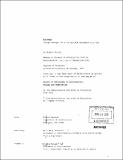bitCar : design concept for a collapsible stackable city car
Author(s)
Vairani, Franco, 1973-
DownloadFull printable version (46.40Mb)
Alternative title
Bit Car : design concept for a collapsible stackable city car
Design concept for a collapsible stackable city car
Other Contributors
Massachusetts Institute of Technology. Dept. of Architecture.
Advisor
William J. Mitchell.
Terms of use
Metadata
Show full item recordAbstract
Problems associated with the massive adoption of automobiles have become the center of a world-wide debate. While new technologies will eventually discover a sustainable solution to the environmental concerns (pollution, depletion of energy sources), cities will continue struggling to accommodate the increasing number of cars. The ability for people to move quickly across large distances and the infrastructure required by the automobile (mainly roads and parking) have also created an unsustainable urban landscape in many countries. The argument of this work is that these problems are partly the result of an outdated set of design premises for the automobile which have not changed since it appeared in the late 1800's. A typical car is too big, too heavy, most of the times it only transports one person for a few miles, and then it remains unused for 95% of the time. These inefficiencies multiplied by the staggering number of vehicles in circulation have resulted in huge energy losses, pollution and vast portions of the city lost in support systems for the car. The work discussed here proposes a different approach to urban transportation, by combining the advantages of mass transit with the convenience of personal mobility. Instead of designing automobiles to fullfil any kind of travel need and additional parking structures destined to accommodate 85% of these automobiles, this work proposes a reconfiguration of the car based on the characteristics of the majority of vehicular urban travel. (cont.) The design of the car operates on a shared-ownership model, with a collapsible structure that allows vehicles to contract and park in stacks. Based on the available data, results indicate that such a design could potentially reduce the actual space requirements for a car between 1/20th and 1/75th. The design of the car is complemented by the use of electric in-wheel motors, developed in connection with the Smart Cities group run at the MIT Media Laboratory under the supervision of Professor Mitchell, for additional efficiency, especially in terms of energy consumption.
Description
Thesis (Ph. D.)--Massachusetts Institute of Technology, Dept. of Architecture, 2009. Page 214 blank. Includes bibliographical references (p. 209-213).
Date issued
2009Department
Massachusetts Institute of Technology. Department of ArchitecturePublisher
Massachusetts Institute of Technology
Keywords
Architecture.